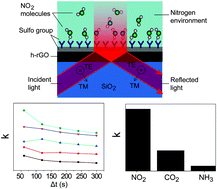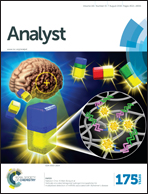Chemically modified graphene films for high-performance optical NO2 sensors†
Abstract
Various graphene-based gas sensors that operate based on the electrical properties of graphene have been developed for accurate detection of gas components. However, electronic graphene-based gas sensors are unsafe under explosive atmospheres and sensitive to electromagnetic interference. Here, a novel optical graphene-based gas sensor for NO2 detection is established based on surface chemical modification of high-temperature-reduced graphene oxide (h-rGO) films with sulfo groups. Sulfo group-modified h-rGO (S-h-rGO) films with a thickness of several nanometers exhibit excellent performance in NO2 detection at room temperature and atmospheric pressure based on the polarization absorption effect of graphene. Initial slope analysis of the S-h-rGO sensor indicates that it has a limit of detection of 0.28 ppm and a response time of 300 s for NO2 gas sensing. Furthermore, the S-h-rGO sensor also possesses the advantages of good linearity, reversibility, selectivity, non-contact operation, low cost and safety. This novel optical gas sensor has the potential to serve as a general platform for the selective detection of a variety of gases with high performance.


 Please wait while we load your content...
Please wait while we load your content...